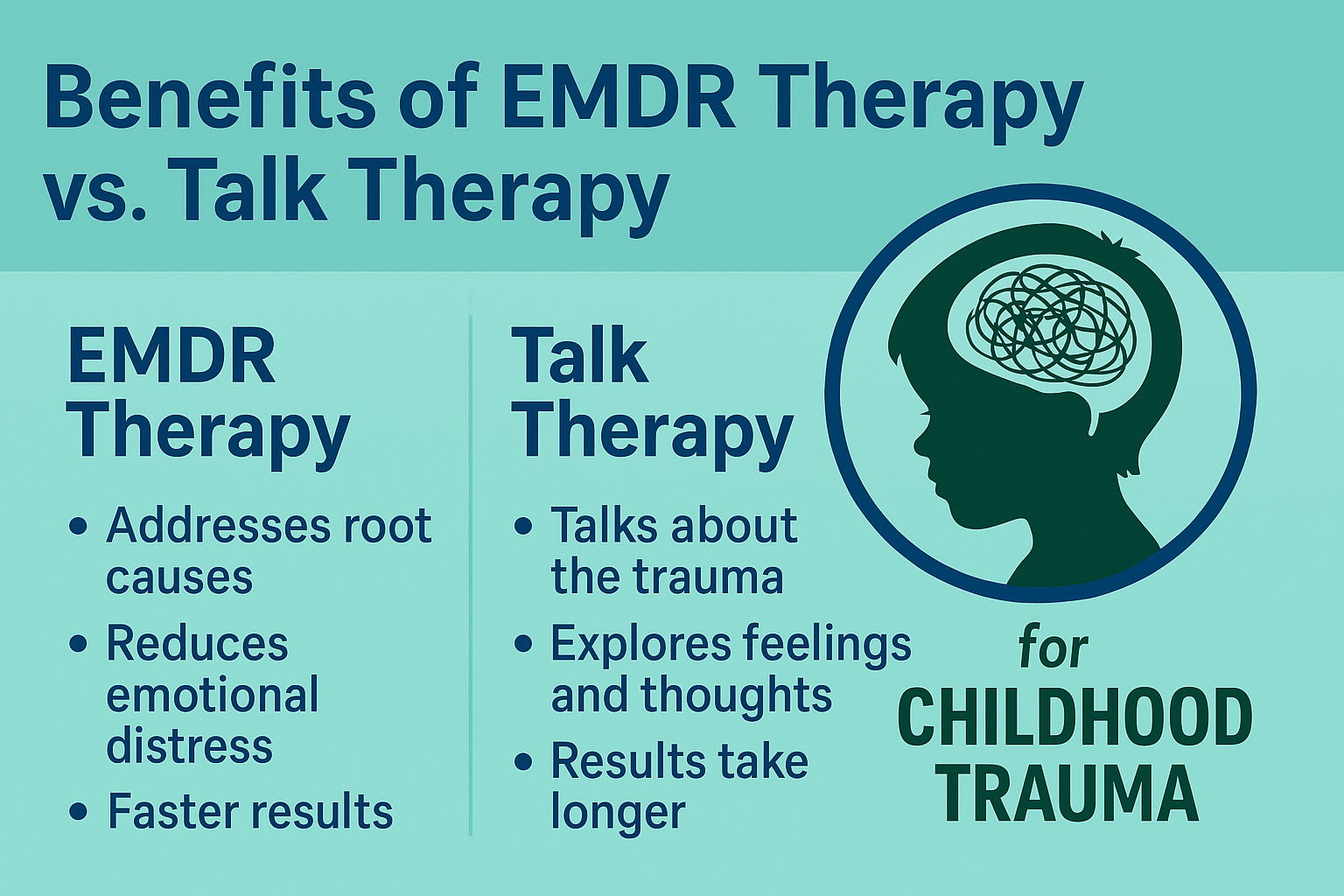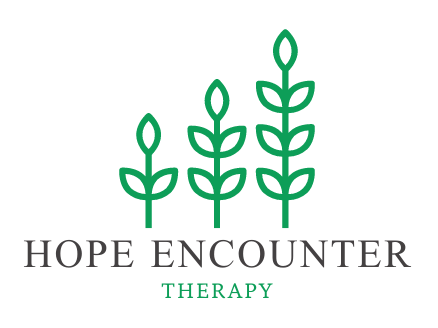Childhood trauma can leave deep and lasting scars. It can affect a person’s emotions, mental health, and even physical well-being. For a long time, traditional talk therapy has been the go-to method for helping people heal from trauma. While it can be helpful, there’s another approach that often works better for childhood trauma. It’s called Eye Movement Desensitization and Reprocessing, or EMDR.
In this blog post, we’ll look at how EMDR therapy works and why it’s often more effective than talk therapy for healing from childhood trauma.

The Complexity of Childhood Trauma
Childhood trauma often results from experiences like abuse, neglect, loss, or witnessing violence. These traumatic events can fundamentally alter the developing brain, embedding emotional responses that persist into adulthood. Survivors often face symptoms such as anxiety, depression, hypervigilance, and difficulties in forming healthy relationships. Traditional talk therapy aims to address these symptoms by exploring and discussing the traumatic events and associated emotions.
However, trauma does not primarily reside in the rational, verbal parts of the brain. Instead, it is often encoded in the limbic system, which governs emotions and physical responses. This is where talk therapy may fall short. Focusing on rational processing without adequately addressing the non-verbal, somatic aspects of trauma.
How EMDR Works Differently
EMDR takes a fundamentally different approach. Instead of focusing solely on discussing trauma, it engages the brain’s natural healing processes through bilateral stimulation—typically eye movements, taps, or sounds. This stimulation helps the brain reprocess traumatic memories, reducing their emotional intensity and allowing for healthier emotional integration.
One key reason EMDR is more effective than talk therapy for childhood trauma is that it works directly with the nervous system. Trauma often gets stuck in the body, creating patterns of fear and hyperarousal that talk therapy alone may not resolve. EMDR, by activating both hemispheres of the brain, helps move the trauma from the reactive emotional centers to the more rational parts of the brain where it can be better understood and contextualized.
Evidence Supporting EMDR’s Effectiveness
Research consistently supports EMDR’s efficacy in treating trauma. Studies have shown that EMDR can lead to significant and rapid reductions in PTSD symptoms, often in fewer sessions than talk therapy. For example, a meta-analysis published in the Journal of Clinical Psychology found that EMDR produced a higher rate of trauma resolution compared to cognitive behavioral therapy (CBT).
In the context of childhood trauma, EMDR’s focus on reprocessing fragmented, non-verbal memories makes it uniquely suited to this population. Many survivors of childhood trauma have difficulty verbalizing their experiences, either because the trauma occurred at a pre-verbal stage of development or because discussing it triggers overwhelming emotions. EMDR offers a way to process these memories without requiring detailed verbal recounting, thus reducing the risk of retraumatization.

Why Talk Therapy Sometimes Falls Short
While talk therapy can be beneficial, it often requires survivors to revisit traumatic memories in a way that can feel emotionally overwhelming. Additionally, because it is primarily a cognitive process, it may not fully address the physiological components of trauma. EMDR, on the other hand, integrates cognitive and somatic healing by allowing the body to participate in processing the trauma.
Another limitation of talk therapy is that it can inadvertently reinforce trauma patterns by repeatedly discussing the traumatic event without moving towards resolution. In contrast, EMDR’s structured phases ensure that clients move through the trauma rather than getting stuck reliving it.
Real-Life Case Study: Healing Through EMDR
Sarah, a 32-year-old woman, had struggled with anxiety, panic attacks, and low self-esteem since childhood, stemming from prolonged exposure to domestic violence. Despite years of talk therapy, Sarah found herself constantly triggered by loud noises and conflict, which made relationships challenging.
After starting EMDR therapy, Sarah noticed a shift within just a few sessions. Rather than reliving the trauma through talk therapy, EMDR allowed her to process the fear and shame on a deeper, non-verbal level. As she reprocessed specific traumatic memories, the emotional charge around them diminished. Sarah reported feeling more in control of her responses and less reactive to triggering situations. Over time, her anxiety reduced significantly, and she began to build healthier, more trusting relationships.
EMDR: A More Holistic Approach
Survivors who have undergone EMDR often report feeling lighter, more grounded, and less triggered by memories. Because EMDR does not require verbal recounting, it is particularly helpful for those who have difficulty talking about their past or who have suppressed memories that surface only as sensations or fragmented images.
EMDR also empowers individuals by fostering a sense of control over their own healing process. Through guided reprocessing with a skilled EMDR therapist, they learn to associate traumatic memories with more positive and adaptive beliefs, helping to break the cycle of trauma responses.
Ready to Heal from Childhood Trauma? EMDR Therapy Can Help
While talk therapy remains a valuable tool in the therapeutic arsenal, EMDR’s unique approach to addressing childhood trauma makes it a more effective option for many individuals. By directly engaging the brain’s natural healing mechanisms, EMDR offers faster, more profound, and longer-lasting relief from the burdens of trauma. If you or someone you know is struggling with childhood trauma, consider exploring EMDR as a path toward healing.
Would you like to learn more about how EMDR can change your life? Reach out to us at Hope Encounter Therapy.

Heal From Childhood Trauma With EMDR Therapy in Raleigh, NC
If you’re ready to move beyond the pain of your past, EMDR therapy in Raleigh, NC can help you find lasting relief. At Hope Encounter Therapy, we offer a safe and supportive space to begin your healing journey. Discover how EMDR therapy can help you reclaim your life with confidence and peace. Follow these three simple steps to get started:
- Contact us for a free consultation.
- Meet with one of our skilled EMDR therapists.
- Start your healing from childhood trauma!
Additional Services Offered at Hope Encounter Therapy
At Hope Encounter Therapy, we support individuals and couples as they work through healing and personal growth. While EMDR therapy is one of our main specialties, we know that healing isn’t one-size-fits-all. That’s why we also offer Cognitive Processing Therapy (CPT), Somatic Experiencing, and Narrative Therapy to tailor care to each person’s needs. Our individual therapy services also focus on trauma recovery. Be sure to visit our blog for helpful tips, insights, and mental health resources.

